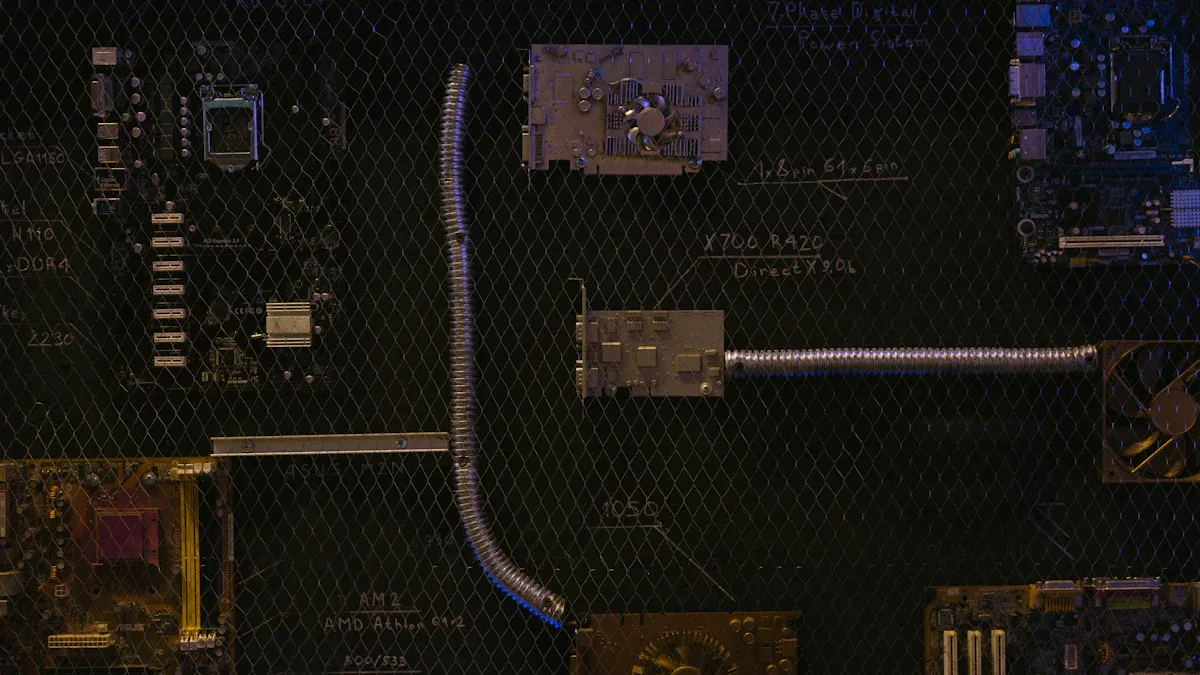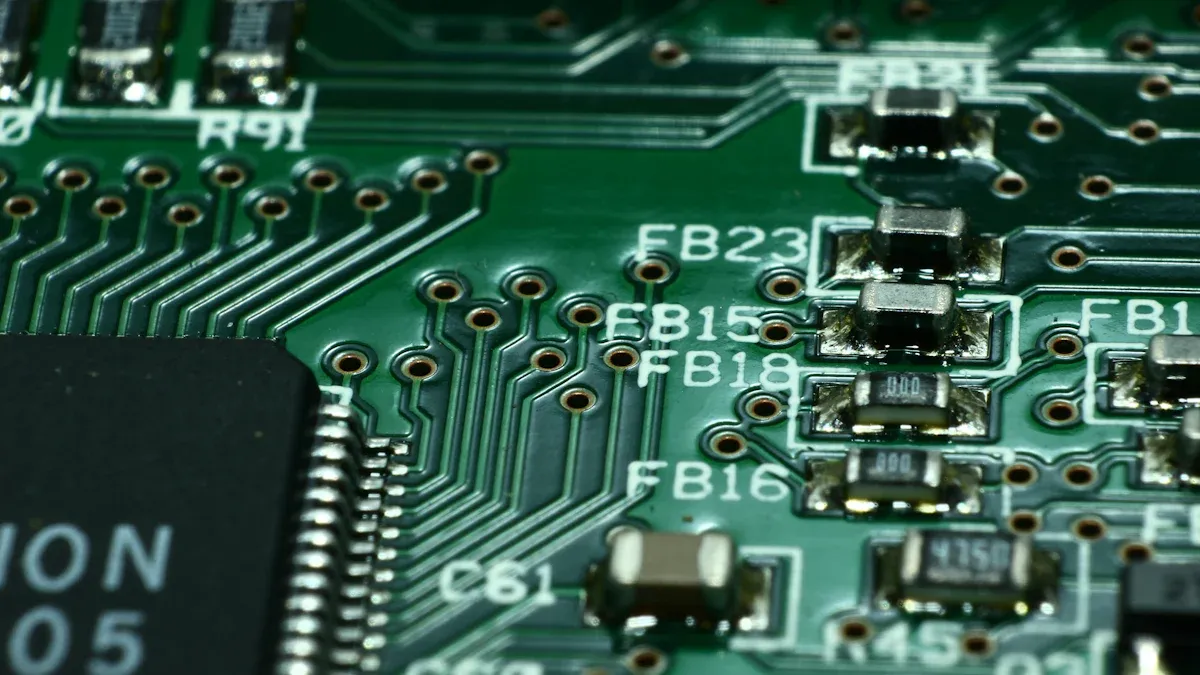RTL8211FD-CG: 5 Key Features You Need to Know

The Realtek RTL8211FD-CG stands as a highly integrated and efficient Gigabit Ethernet transceiver. It delivers robust network connectivity solutions for diverse applications. These include Digital TV, game consoles, printers, and various networking equipment like Ethernet hubs and switches. This blog explores the five most crucial features that make the RTL8211FD-CG a compelling choice for designers and engineers. These features offer enhanced performance, superior power efficiency, and simplified integration for various projects.
Key Takeaways
The RTL8211FD-CG is a fast network chip. It works with different internet speeds like 10, 100, and 1000 Mbps.
This chip saves power. It uses special modes to use less energy when not busy. It can also wake up your computer when needed.
The chip has many parts built inside. This makes it easier to design new devices. It also saves space on circuit boards.
It works well in noisy places. The chip does not cause or get bothered by electronic interference. This makes it good for factories.
The chip connects easily to other parts. It has different ways to link up with other computer chips. This helps it fit into many devices.
High-Performance RTL8211FD-CG Gigabit

The RTL8211FD-CG delivers exceptional performance for Gigabit Ethernet applications. It ensures reliable and fast network connections. This transceiver integrates advanced technologies to maintain data integrity and speed across various network environments.
Multi-Speed Ethernet Support
This transceiver supports multiple Ethernet speeds. It operates seamlessly at 10 Mbps, 100 Mbps, and 1000 Mbps. This multi-speed capability allows the device to adapt to different network requirements. It ensures compatibility with both older and newer network infrastructures.
Industry Standard Compliance
The RTL8211FD-CG adheres to industry standards. It fully complies with IEEE 802.3, the standard for Ethernet. This compliance guarantees interoperability with other network devices. It also ensures reliable communication within diverse network setups.
Auto-Negotiation and MDIX
The RTL8211FD-CG simplifies network setup through its auto-negotiation and MDIX features. Auto-negotiation automatically detects the optimal speed and duplex mode between connected devices. This eliminates manual configuration. The device also integrates Crossover Detection & Auto-Correction and Automatic polarity correction. These functionalities enhance network compatibility. They ensure robust transmission and reception across all supported speeds. Furthermore, auto-MDI/MDIX automatically detects and corrects straight-through or crossover cable configurations. This feature removes the need for specific cable types, simplifying installation and improving ease of use.
Optimized Data Throughput
The RTL8211FD-CG achieves optimized data throughput through sophisticated signal processing. It employs state-of-the-art DSP technology and an Analog Front End (AFE). These technologies ensure reliable data transmission over Unshielded Twisted Pair (UTP) cables. Key functions include:
Crossover Detection & Auto-Correction
Polarity correction
Adaptive equalization
Cross-talk cancellation
Echo cancellation
Timing recovery
Error correction
These features work together to maintain signal quality and minimize data loss. The transceiver consistently delivers high data rates under various operating conditions:
Operating Condition | Data Throughput Rate |
|---|---|
Standard Operation | 10 Mb/s |
Standard Operation | 100 Mb/s |
Standard Operation | 1 Gb/s |
Advanced Power Management

The RTL8211FD-CG excels in power efficiency. It incorporates several features that significantly reduce energy consumption. These features make it an ideal choice for power-sensitive applications.
Energy-Efficient Ethernet (EEE)
The RTL8211FD-CG supports IEEE 802.3az-2010, also known as Energy Efficient Ethernet (EEE). This standard includes a Low Power Idle mode. The system transitions to a lower power consumption level when no packets transmit. It disables most circuits to save power. The device quickly returns to normal mode when needed.
Low Power Modes
The transceiver offers various low power modes to optimize energy use. It supports IEEE 802.3az-2010 (Energy Efficient Ethernet). It also features built-in Wake-on-LAN (WOL). The device supports PHYRSTB core power Turn-Off. It includes Link Down power saving. Green Ethernet is available for 1000/100Mbps modes. These modes collectively ensure efficient power management.
Wake-on-LAN (WoL)
Wake-on-LAN (WOL) is a key power-saving feature. The RTL8211FD-CG monitors the network for a Wakeup Frame or Magic Packet. It then notifies the system to wake up via the PMEB pin. This allows systems to remain in a low-power state until network activity requires them.
Flexible Power Options
The RTL8211FD-CG offers flexible power supply options. It supports multiple voltage levels for integration into diverse systems.
Voltage Type | Value |
|---|---|
3.3 V | |
Supply Voltage - Min | 1.8 V |
The device operates with supply voltages of 3.3V, 2.5V, 1.8V, and 1.5V. This flexibility simplifies power supply design for engineers. It allows for broader application compatibility.
Integrated Design Features
The RTL8211FD-CG stands out for its highly integrated design. This approach simplifies system development and reduces overall component count. Engineers benefit from a streamlined design process and a smaller physical footprint.
PHY and MAC Layer Integration
The RTL8211FD-CG integrates both the Physical Layer (PHY) and Media Access Control (MAC) layer functionalities. This combination significantly simplifies board design. It reduces the number of external components required for network connectivity. This integration also contributes to a smaller overall solution size. The device comes in a compact package, such as a QFN-48. This small footprint saves valuable board space in various applications. Designers can achieve more compact and efficient product designs.
On-Chip Voltage Regulator
This transceiver includes an on-chip voltage regulator. This feature eliminates the need for external power management components. It further reduces the bill of materials (BOM) and simplifies power supply design. The integrated regulator incorporates both a built-in switching regulator and an LDO (Low-Dropout) regulator. This provides stable and efficient power delivery to the chip's internal circuits. This design choice simplifies power management for the entire system.
Built-in Termination Resistors
The RTL8211FD-CG features built-in termination resistors. These resistors are essential for maintaining signal integrity on the Ethernet lines. They effectively reduce signal reflections and ensure proper data transmission. This integration removes the need for external termination components on the PCB. It simplifies the board layout and reduces overall system cost. This also helps in achieving better electromagnetic compatibility (EMC) performance.
Diagnostic Tools
The device offers various diagnostic tools. These tools assist engineers in monitoring network performance. They also help in troubleshooting connectivity issues efficiently. Features like cable diagnostics can detect faults within the Ethernet cable. This capability speeds up development and deployment phases. It also helps maintain network reliability in the field. These integrated tools provide valuable insights for system maintenance and optimization.
Robust EMI/EMC Performance
Network devices must operate reliably in diverse environments. The design of this transceiver prioritizes robust Electromagnetic Interference (EMI) and Electromagnetic Compatibility (EMC) performance. This ensures stable operation and minimizes disruptions to other electronic systems.
Electromagnetic Compatibility
The transceiver demonstrates strong electromagnetic compatibility. It adheres to strict industry standards for both emissions and immunity. This compliance means the device does not generate excessive electromagnetic noise. It also functions correctly when exposed to external electromagnetic fields. This capability is crucial for integration into sensitive electronic systems.
Reduced Interference (EMI)
The design actively reduces electromagnetic interference. Engineers implemented careful layout and shielding techniques. These measures minimize unwanted electromagnetic emissions from the device itself. Lower EMI levels prevent the transceiver from disrupting nearby components or systems. This contributes to a cleaner electromagnetic environment for the entire product.
Enhanced Noise Immunity
This device features enhanced noise immunity. It resists external electromagnetic noise and interference. This resilience ensures stable data transmission even in electrically noisy settings. The robust design protects against common sources of interference. These sources include power lines, motors, and other electronic equipment. This capability maintains signal integrity and network reliability.
Industrial Environment Suitability
The robust EMI/EMC performance makes this transceiver highly suitable for industrial environments. These settings often present significant electromagnetic challenges. The device's ability to operate without causing or succumbing to interference is critical. It ensures reliable network connectivity in factories, automation systems, and other demanding applications. This reliability is essential for continuous operation and data integrity in harsh conditions.
Flexible Interface Options
The RTL8211FD-CG offers a variety of flexible interface options. These options ensure seamless integration into diverse system architectures. Designers can easily connect this transceiver to various MAC controllers and manage its functions.
RGMII Support
The device supports the Reduced Gigabit Media Independent Interface (RGMII). This interface facilitates efficient data transfer between the MAC and PHY layers. It handles 1000Base-T, 10Base-T, and 100Base-TX Ethernet speeds. Engineers can select RGMII signaling voltages. Options include 3.3V, 2.5V, 1.8V, and 1.5V. This flexibility allows compatibility with different system voltage requirements.
MAC Controller Compatibility
The transceiver ensures broad compatibility with various MAC controllers. It supports both RGMII and MII interfaces. This allows designers to choose the most suitable MAC for their application. The device also features voltage tolerance for 1.8V, 2.5V, and 3.3V. This wide range of voltage support simplifies integration into existing designs. It reduces the need for external voltage level shifters.
Configurable LED Outputs
The RTL8211FD-CG provides configurable LED outputs. These outputs offer visual status indications for network activity. Designers can program these LEDs to show link status, speed, and data transmission. This feature aids in system debugging and user feedback. It allows for clear operational monitoring without complex software interfaces.
MDIO for Configuration
A Management Data Input/Output (MDIO) interface is available for device configuration. Engineers use MDIO to access and modify the transceiver's internal registers. This allows fine-tuning of operational parameters. It also enables advanced diagnostic functions. The MDIO interface provides a standard method for controlling the PHY, ensuring interoperability with various host systems.
The RTL8211FD-CG offers five key features: high-performance Gigabit Ethernet, advanced power management, integrated design, robust EMI/EMC, and flexible interfaces. These combined features make the RTL8211FD-CG an ideal solution for reliable and efficient network connectivity. Designers should consider this transceiver for their projects. It provides significant value across a wide range of applications, from consumer devices to industrial networking. Such integrated and feature-rich transceivers are crucial components in modern network infrastructure.
FAQ
What is the primary function of the RTL8211FD-CG?
The RTL8211FD-CG serves as a highly integrated Gigabit Ethernet transceiver. It provides robust network connectivity for diverse applications. It supports 10 Mbps, 100 Mbps, and 1000 Mbps speeds.
How does the RTL8211FD-CG manage power consumption?
The device utilizes Energy-Efficient Ethernet (EEE) and various low power modes. EEE reduces power during idle times. Wake-on-LAN (WoL) allows the system to remain in a low-power state until network activity requires it.
What are the benefits of the RTL8211FD-CG's integrated design?
Its integrated design combines PHY and MAC layers. This simplifies board design and reduces component count. An on-chip voltage regulator and built-in termination resistors further streamline development. The compact QFN-48 package saves space.
Why is robust EMI/EMC performance important for this transceiver?
Robust EMI/EMC performance ensures stable operation in noisy environments. It minimizes interference with other electronics. This makes the device suitable for industrial settings and sensitive systems. It maintains signal integrity.
What interface options does the RTL8211FD-CG offer?
The RTL8211FD-CG supports the RGMII interface for efficient data transfer. It offers broad compatibility with various MAC controllers. Configurable LED outputs provide visual status. An MDIO interface allows device configuration.
See Also
Demystifying Communication Chips: Understanding Their Inner Workings and Functionality
Best USB to Serial ICs: Essential Chips for 2025 Projects
Exploring Low-Power IoT Chip Technologies: Applications and Core Principles Explained
Leading Microcontrollers for 2025: Featuring Ethernet and Camera Integration
Unveiling Advanced Features: Low-Power Off-Line Switcher ICs Explored in Depth
